Samy’s Camera is unlike any other work environment. If one is a photography buff, a trip to our Corporate offices in Playa Vista or to our Los Angeles store feels a lot like being a kid in a candy store. You see, Samy over the years has amassed quite the camera collection; many of which one may have never have before seen face to face. These cameras (along with some pretty famous prints) are scattered, on display, throughout these locations. One camera, which calls our corporate office home, was recently completed: a pretty serious lens now graces the front of this very mighty-looking camera.
[caption id="attachment_3668" align="aligncenter" width="663"]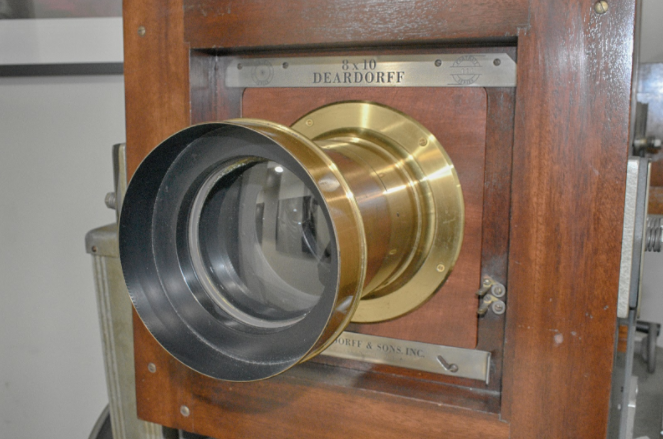 Credit: Ralph Elliott Starkweather[/caption]
To see this 8x10 Deardorff camera in person is overwhelming.
[caption id="attachment_3669" align="aligncenter" width="364"]
Credit: Ralph Elliott Starkweather[/caption]
To see this 8x10 Deardorff camera in person is overwhelming.
[caption id="attachment_3669" align="aligncenter" width="364"]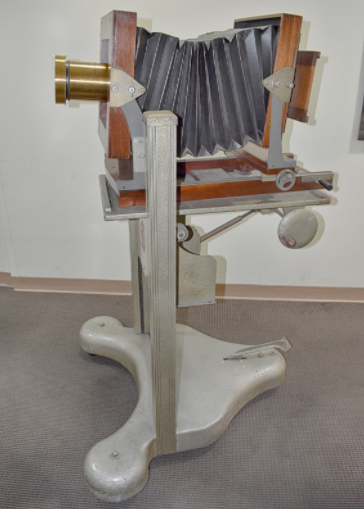 Credit: Ralph Elliott Starkweather[/caption]
Camera and ultra-solid stand included, it’s the height, as pictured, of an average person. Please take a moment to bask in all its retro glory.
Living in the tech age, we often take for granted the power and sophistication, in regards to photography and video, of today’s technology. The average consumer can purchase a camera that is not only capable of also recording high definition video; but, can also fit in your pocket, purse, tote bag, or small camera bag. For many of you, taking that holiday portrait for your holiday card was a simply as attaching one’s camera to a tripod or selfie stick. It’s so easy to forget that it wasn’t always so easy or accessible to capture moments in time, whether still or in a moving image, instantly.
Credit: Ralph Elliott Starkweather[/caption]
Camera and ultra-solid stand included, it’s the height, as pictured, of an average person. Please take a moment to bask in all its retro glory.
Living in the tech age, we often take for granted the power and sophistication, in regards to photography and video, of today’s technology. The average consumer can purchase a camera that is not only capable of also recording high definition video; but, can also fit in your pocket, purse, tote bag, or small camera bag. For many of you, taking that holiday portrait for your holiday card was a simply as attaching one’s camera to a tripod or selfie stick. It’s so easy to forget that it wasn’t always so easy or accessible to capture moments in time, whether still or in a moving image, instantly.
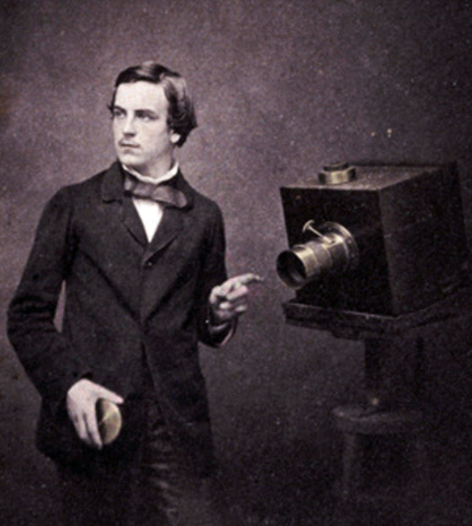 Walter Bentley Woodbury, Self-portrait with a camera, 1857. Source: http://bit.ly/2i2kM02[/caption]
By today’s standards, Woodbury’s camera seen above seems bulky and cumbersome. The modern individual, seeing how technology, from computers, to tv’s, to phones, to cameras, continues to get smaller and more compact, thinks of yesterday’s film cameras (pertaining to both still and cinema cameras) as being oversized. Sure, this example of mid-19th century photographic technology pictured above can’t fit into a backpack; but, it could be moved from place to place. Early film cameras weren’t so bad moving between locations either. However, thanks to The Jazz Singer, cinema’s first talkie, sound and fancy color treatments required more advanced (and larger) hardware.
[caption id="attachment_3671" align="aligncenter" width="640"]
Walter Bentley Woodbury, Self-portrait with a camera, 1857. Source: http://bit.ly/2i2kM02[/caption]
By today’s standards, Woodbury’s camera seen above seems bulky and cumbersome. The modern individual, seeing how technology, from computers, to tv’s, to phones, to cameras, continues to get smaller and more compact, thinks of yesterday’s film cameras (pertaining to both still and cinema cameras) as being oversized. Sure, this example of mid-19th century photographic technology pictured above can’t fit into a backpack; but, it could be moved from place to place. Early film cameras weren’t so bad moving between locations either. However, thanks to The Jazz Singer, cinema’s first talkie, sound and fancy color treatments required more advanced (and larger) hardware.
[caption id="attachment_3671" align="aligncenter" width="640"]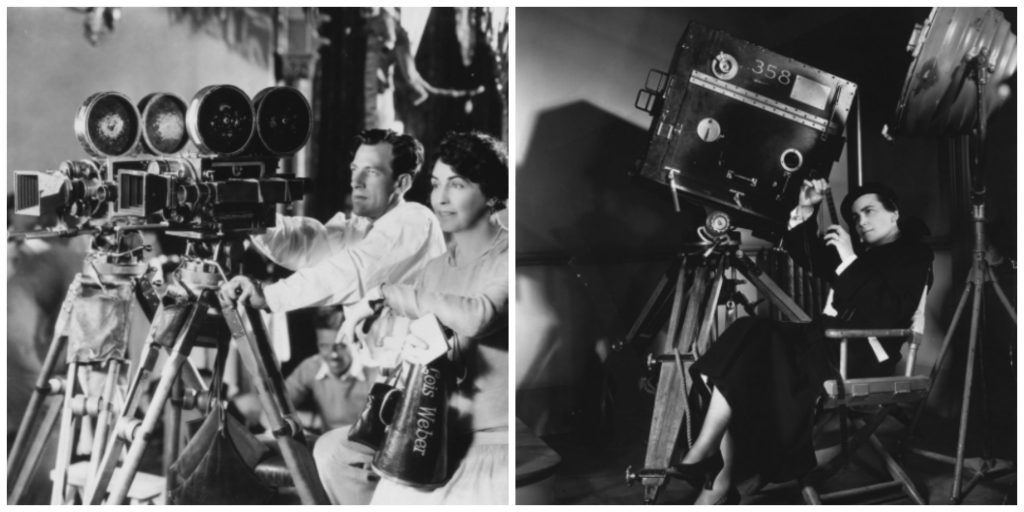 Size matters: (left) Silent film actress and director Lois Weber and director D.W. Griffith behind film cameras | (right) Dorothy Arzner, directing Merrily We Go to Hell (1932), seated in front of studio film camera. Source: http://bit.ly/1i8KXBV[/caption]
With all the bells and whistles attached, one may wonder just how photographers moved the Deardorff 8x10 camera around, it they ever moved it around at all. Keep in mind that the lens and stand give the above photo its extra bulk. Believe it or not, being a field camera and all, the Deardorff 8x10 cameras, unlike the film cameras from around the same period, were designed to go wherever the photographer needed to go.
Size matters: (left) Silent film actress and director Lois Weber and director D.W. Griffith behind film cameras | (right) Dorothy Arzner, directing Merrily We Go to Hell (1932), seated in front of studio film camera. Source: http://bit.ly/1i8KXBV[/caption]
With all the bells and whistles attached, one may wonder just how photographers moved the Deardorff 8x10 camera around, it they ever moved it around at all. Keep in mind that the lens and stand give the above photo its extra bulk. Believe it or not, being a field camera and all, the Deardorff 8x10 cameras, unlike the film cameras from around the same period, were designed to go wherever the photographer needed to go.
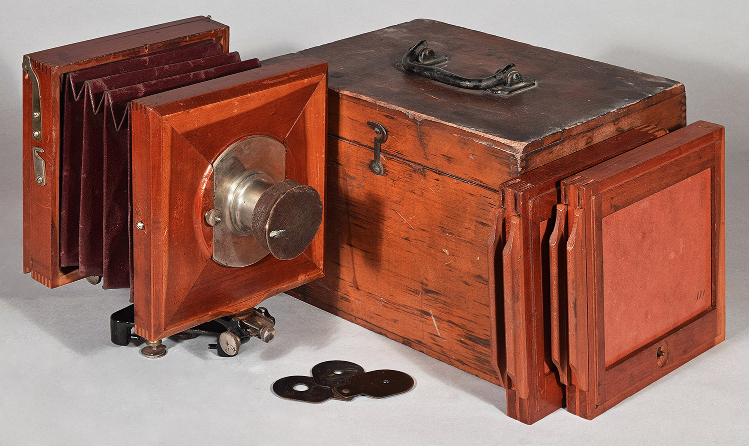 A Rochester Optical Co. American Challenge Swivel Bed Camera 4x5" (1881-1887) Source: http://bit.ly/2ih8ss8[/caption]
Both classic and modern versions offer a compact and portable design for photographers that required a larger negative size. However, classic field cameras are limited when it comes to camera movements. Modern field cameras addressed these challenges by including lens rise/fall/shift/tilt/swing capabilities.
Speaking of compact, did you notice anything that these older field cameras and the Deardorff 8x10 have in common? See the part that looks like an accordion:
Remove the lens and dismantle from the stand, and the Deardorff 8x10, along with its other models, fold down to something along the lines of a wooden briefcase.
[caption id="attachment_3673" align="aligncenter" width="640"]
A Rochester Optical Co. American Challenge Swivel Bed Camera 4x5" (1881-1887) Source: http://bit.ly/2ih8ss8[/caption]
Both classic and modern versions offer a compact and portable design for photographers that required a larger negative size. However, classic field cameras are limited when it comes to camera movements. Modern field cameras addressed these challenges by including lens rise/fall/shift/tilt/swing capabilities.
Speaking of compact, did you notice anything that these older field cameras and the Deardorff 8x10 have in common? See the part that looks like an accordion:
Remove the lens and dismantle from the stand, and the Deardorff 8x10, along with its other models, fold down to something along the lines of a wooden briefcase.
[caption id="attachment_3673" align="aligncenter" width="640"] Left: Deardorff 4x4 camera | Center: Deardorff 5x7 camera | Right: Deardorff 8x10 camera (closed) Sources: http://bit.ly/2ih7CMa | http://bit.ly/2hUXBFy | http://bit.ly/2iclwmz[/caption]
Left: Deardorff 4x4 camera | Center: Deardorff 5x7 camera | Right: Deardorff 8x10 camera (closed) Sources: http://bit.ly/2ih7CMa | http://bit.ly/2hUXBFy | http://bit.ly/2iclwmz[/caption]
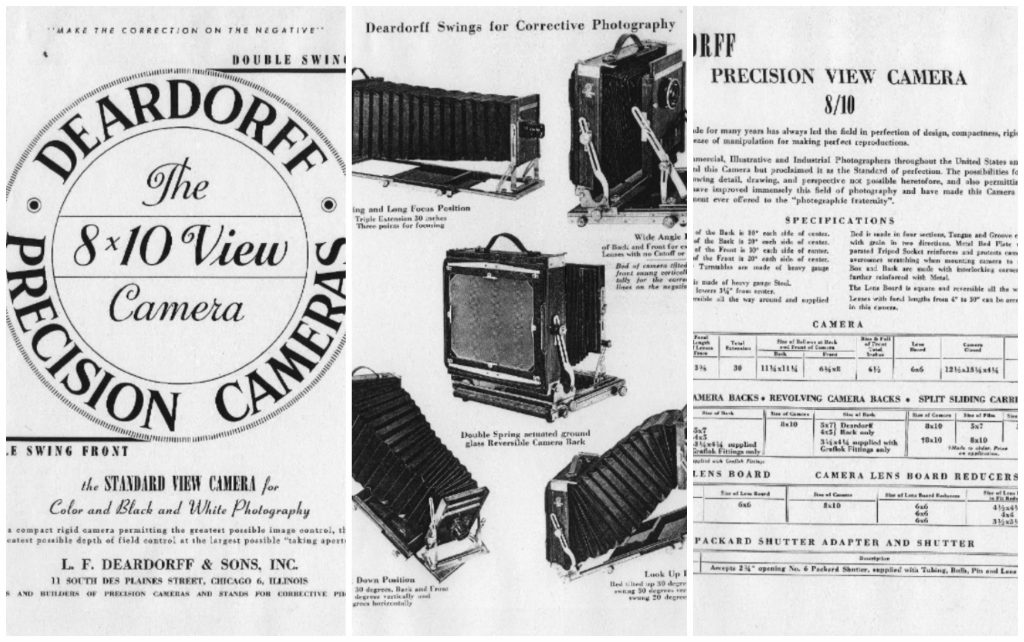 Deardorff 8x10 manual Source: http://bit.ly/2ihavwA[/caption]
The name “Deardorff” became famous thanks to its large-format, wooden construction cameras. Along with the company’s larger bellows view camera, Deardorff’s, becoming a staple in professional photography studios, were manufactured from 1923 until 1988. Laben F., the L.F. in L.F. Deardorff & Sons, Inc, previously served as a repairman for Rochester Camera Company just before the turn of the 20th century. Beginning in 1923, the original 15 models of the Deardorff V8 were built.
Deardorff 8x10 manual Source: http://bit.ly/2ihavwA[/caption]
The name “Deardorff” became famous thanks to its large-format, wooden construction cameras. Along with the company’s larger bellows view camera, Deardorff’s, becoming a staple in professional photography studios, were manufactured from 1923 until 1988. Laben F., the L.F. in L.F. Deardorff & Sons, Inc, previously served as a repairman for Rochester Camera Company just before the turn of the 20th century. Beginning in 1923, the original 15 models of the Deardorff V8 were built.
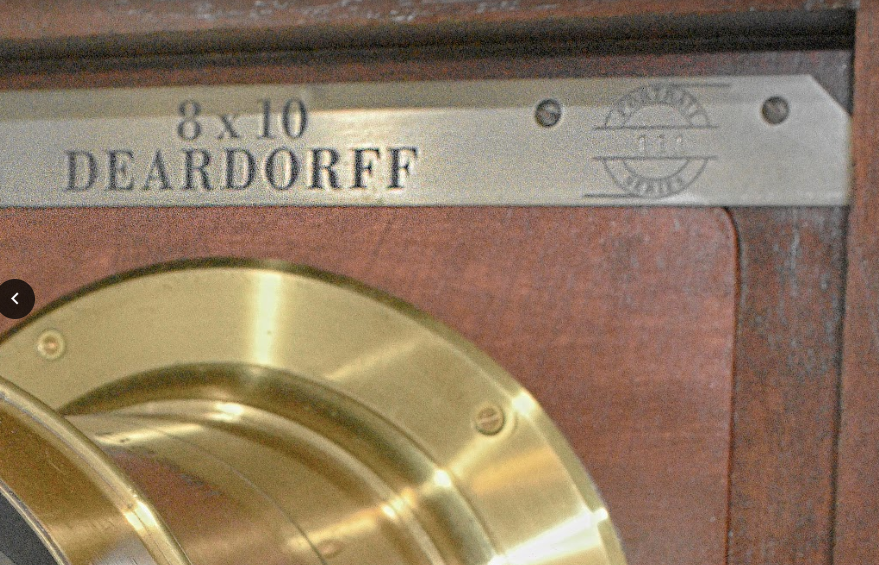 Credit: Ralph Elliott Starkweather[/caption]
The round marking states the following: Portrait Series #111. Those three numbers serve as a clue into finding out the age of this specific camera.
After doing some digging at both the local library and the internet, an additional clue was discovered in a Large Format Photography Forum (yes, such a thing exists). Remember Ken Hough, the Deardorff builder mentioned previously. Hough also happens to be the current go-to online authority on everything Deardorff. Not only does he specialize in Deardorff restorations; he also is behind, as stated on the website, “the webs most authoritative Deardorff Historical Web Site.” Per this forum and according to Hough, serial numbers after 100 were made after 1949 and ended at 6503 in 1989. With that bit of information, one can make an educated guess that #111 was manufactured sometime between 1949 and 1950.
Credit: Ralph Elliott Starkweather[/caption]
The round marking states the following: Portrait Series #111. Those three numbers serve as a clue into finding out the age of this specific camera.
After doing some digging at both the local library and the internet, an additional clue was discovered in a Large Format Photography Forum (yes, such a thing exists). Remember Ken Hough, the Deardorff builder mentioned previously. Hough also happens to be the current go-to online authority on everything Deardorff. Not only does he specialize in Deardorff restorations; he also is behind, as stated on the website, “the webs most authoritative Deardorff Historical Web Site.” Per this forum and according to Hough, serial numbers after 100 were made after 1949 and ended at 6503 in 1989. With that bit of information, one can make an educated guess that #111 was manufactured sometime between 1949 and 1950.
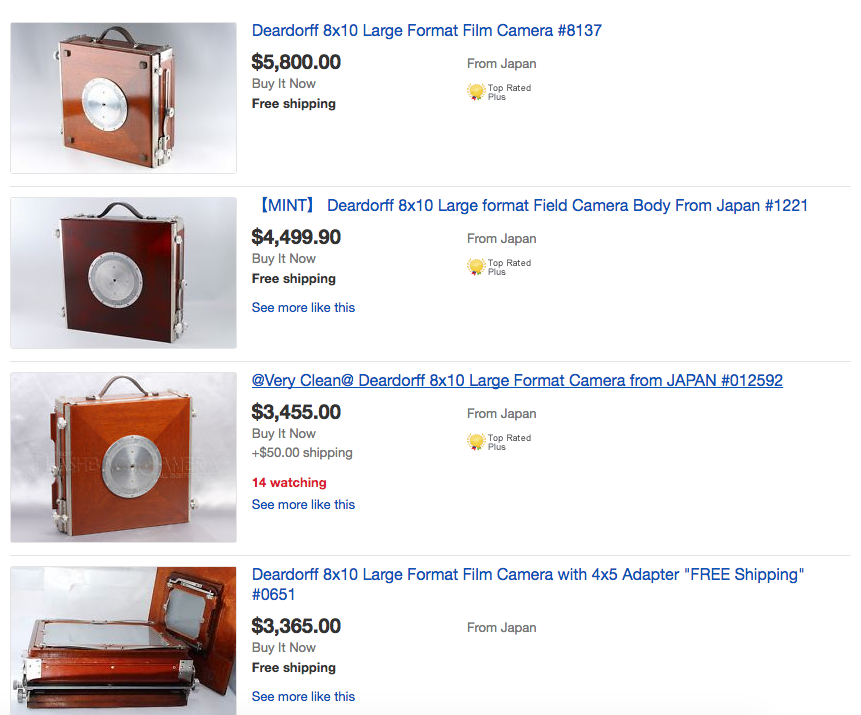 If one happens to come across a Deardorff camera, odds are it’s in used condition, with 1988 being the company’s last year in production. However, according to Wikipedia, Deardorff’s, in limited quantities and built to original Chicago specifications, are still in production today.
Just because the Deardorff 8x10 found at Samy’s is on display, doesn’t mean that these cameras are not still functional. As a matter of fact, hence such gems as the large format forum, some of today’s photographers continue to experiment with retro large format cameras. Photographer David R. Munson’s review of the, you guessed it, Deardorff 8x10 field camera for largeformatphotography.info, aside from a few concerns regarding the camera’s knobs and control for both front rise and tilt, is surprisingly positive:
“I bought my Deardorff 8x10 in the spring of 2000 and have been quite fond of the thing ever since. I've refinished all the wood and replaced the bellows and the handle, and at this point it's about as nice a camera as I've ever had occasion to use, let alone own. I've used it for everything from landscape to architecture to portraiture...Overall, my impression of using the Deardorff 8x10 in the field is overwhelmingly positive. Operation is smooth and intuitive, the camera is rugged and reliable, and to add a completely subjective element it just feels right.”
[caption id="attachment_3677" align="aligncenter" width="554"]
If one happens to come across a Deardorff camera, odds are it’s in used condition, with 1988 being the company’s last year in production. However, according to Wikipedia, Deardorff’s, in limited quantities and built to original Chicago specifications, are still in production today.
Just because the Deardorff 8x10 found at Samy’s is on display, doesn’t mean that these cameras are not still functional. As a matter of fact, hence such gems as the large format forum, some of today’s photographers continue to experiment with retro large format cameras. Photographer David R. Munson’s review of the, you guessed it, Deardorff 8x10 field camera for largeformatphotography.info, aside from a few concerns regarding the camera’s knobs and control for both front rise and tilt, is surprisingly positive:
“I bought my Deardorff 8x10 in the spring of 2000 and have been quite fond of the thing ever since. I've refinished all the wood and replaced the bellows and the handle, and at this point it's about as nice a camera as I've ever had occasion to use, let alone own. I've used it for everything from landscape to architecture to portraiture...Overall, my impression of using the Deardorff 8x10 in the field is overwhelmingly positive. Operation is smooth and intuitive, the camera is rugged and reliable, and to add a completely subjective element it just feels right.”
[caption id="attachment_3677" align="aligncenter" width="554"]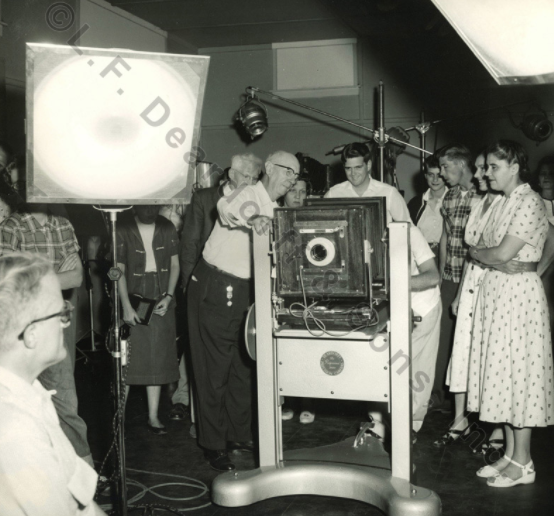 Credit: L.F. Deardorff & Sons[/caption]
Sure, purchasing the latest DSLR is very exciting and snapping a quick on one’s smartphone has become the norm. However, whenever you can, do spend some time with a real-deal retro camera. Not only are they fun to research, stepping behind a functional retro camera serves as a trip back in time before self timers and post-production filters.
Credit: L.F. Deardorff & Sons[/caption]
Sure, purchasing the latest DSLR is very exciting and snapping a quick on one’s smartphone has become the norm. However, whenever you can, do spend some time with a real-deal retro camera. Not only are they fun to research, stepping behind a functional retro camera serves as a trip back in time before self timers and post-production filters.
 Credit: Ralph Elliott Starkweather[/caption]
To see this 8x10 Deardorff camera in person is overwhelming.
[caption id="attachment_3669" align="aligncenter" width="364"]
Credit: Ralph Elliott Starkweather[/caption]
To see this 8x10 Deardorff camera in person is overwhelming.
[caption id="attachment_3669" align="aligncenter" width="364"] Credit: Ralph Elliott Starkweather[/caption]
Camera and ultra-solid stand included, it’s the height, as pictured, of an average person. Please take a moment to bask in all its retro glory.
Living in the tech age, we often take for granted the power and sophistication, in regards to photography and video, of today’s technology. The average consumer can purchase a camera that is not only capable of also recording high definition video; but, can also fit in your pocket, purse, tote bag, or small camera bag. For many of you, taking that holiday portrait for your holiday card was a simply as attaching one’s camera to a tripod or selfie stick. It’s so easy to forget that it wasn’t always so easy or accessible to capture moments in time, whether still or in a moving image, instantly.
Credit: Ralph Elliott Starkweather[/caption]
Camera and ultra-solid stand included, it’s the height, as pictured, of an average person. Please take a moment to bask in all its retro glory.
Living in the tech age, we often take for granted the power and sophistication, in regards to photography and video, of today’s technology. The average consumer can purchase a camera that is not only capable of also recording high definition video; but, can also fit in your pocket, purse, tote bag, or small camera bag. For many of you, taking that holiday portrait for your holiday card was a simply as attaching one’s camera to a tripod or selfie stick. It’s so easy to forget that it wasn’t always so easy or accessible to capture moments in time, whether still or in a moving image, instantly.
Putting the Large in Large Format
According to Wikipedia, Large format refers to any imaging format of 4×5 inches or larger. Before enlargers become common, photographers would make 1:1 contact prints from a 4×5, 5×7, or 8×10-inch negative. While 4x5 inch large format prints would be the norm between 1930-1950, images above 8x10 inches are labeled as ULF, or Ultra Large Format. [caption id="attachment_3670" align="aligncenter" width="472"] Walter Bentley Woodbury, Self-portrait with a camera, 1857. Source: http://bit.ly/2i2kM02[/caption]
By today’s standards, Woodbury’s camera seen above seems bulky and cumbersome. The modern individual, seeing how technology, from computers, to tv’s, to phones, to cameras, continues to get smaller and more compact, thinks of yesterday’s film cameras (pertaining to both still and cinema cameras) as being oversized. Sure, this example of mid-19th century photographic technology pictured above can’t fit into a backpack; but, it could be moved from place to place. Early film cameras weren’t so bad moving between locations either. However, thanks to The Jazz Singer, cinema’s first talkie, sound and fancy color treatments required more advanced (and larger) hardware.
[caption id="attachment_3671" align="aligncenter" width="640"]
Walter Bentley Woodbury, Self-portrait with a camera, 1857. Source: http://bit.ly/2i2kM02[/caption]
By today’s standards, Woodbury’s camera seen above seems bulky and cumbersome. The modern individual, seeing how technology, from computers, to tv’s, to phones, to cameras, continues to get smaller and more compact, thinks of yesterday’s film cameras (pertaining to both still and cinema cameras) as being oversized. Sure, this example of mid-19th century photographic technology pictured above can’t fit into a backpack; but, it could be moved from place to place. Early film cameras weren’t so bad moving between locations either. However, thanks to The Jazz Singer, cinema’s first talkie, sound and fancy color treatments required more advanced (and larger) hardware.
[caption id="attachment_3671" align="aligncenter" width="640"] Size matters: (left) Silent film actress and director Lois Weber and director D.W. Griffith behind film cameras | (right) Dorothy Arzner, directing Merrily We Go to Hell (1932), seated in front of studio film camera. Source: http://bit.ly/1i8KXBV[/caption]
With all the bells and whistles attached, one may wonder just how photographers moved the Deardorff 8x10 camera around, it they ever moved it around at all. Keep in mind that the lens and stand give the above photo its extra bulk. Believe it or not, being a field camera and all, the Deardorff 8x10 cameras, unlike the film cameras from around the same period, were designed to go wherever the photographer needed to go.
Size matters: (left) Silent film actress and director Lois Weber and director D.W. Griffith behind film cameras | (right) Dorothy Arzner, directing Merrily We Go to Hell (1932), seated in front of studio film camera. Source: http://bit.ly/1i8KXBV[/caption]
With all the bells and whistles attached, one may wonder just how photographers moved the Deardorff 8x10 camera around, it they ever moved it around at all. Keep in mind that the lens and stand give the above photo its extra bulk. Believe it or not, being a field camera and all, the Deardorff 8x10 cameras, unlike the film cameras from around the same period, were designed to go wherever the photographer needed to go.
Field Cameras
According to piercevaubel.com, “an explosion in field camera design occurred in the United States occurred between 1870-1930. Rival firms patented designs for beds, reversing mechanisms and plate-holders at a breakneck pace.” Evolving from the early interlocking box cameras of the 1800’s, early pioneers of field cameras, among others, include Kodak and Burke and James. Deardorff, as noted by Wikipedia, is the only camera company to have influenced the field camera sector as both a classic and modern maker. Other modern field camera makers include, among others, Horseman and Lotus View Cameras. [caption id="attachment_3672" align="aligncenter" width="640"] A Rochester Optical Co. American Challenge Swivel Bed Camera 4x5" (1881-1887) Source: http://bit.ly/2ih8ss8[/caption]
Both classic and modern versions offer a compact and portable design for photographers that required a larger negative size. However, classic field cameras are limited when it comes to camera movements. Modern field cameras addressed these challenges by including lens rise/fall/shift/tilt/swing capabilities.
Speaking of compact, did you notice anything that these older field cameras and the Deardorff 8x10 have in common? See the part that looks like an accordion:
Remove the lens and dismantle from the stand, and the Deardorff 8x10, along with its other models, fold down to something along the lines of a wooden briefcase.
[caption id="attachment_3673" align="aligncenter" width="640"]
A Rochester Optical Co. American Challenge Swivel Bed Camera 4x5" (1881-1887) Source: http://bit.ly/2ih8ss8[/caption]
Both classic and modern versions offer a compact and portable design for photographers that required a larger negative size. However, classic field cameras are limited when it comes to camera movements. Modern field cameras addressed these challenges by including lens rise/fall/shift/tilt/swing capabilities.
Speaking of compact, did you notice anything that these older field cameras and the Deardorff 8x10 have in common? See the part that looks like an accordion:
Remove the lens and dismantle from the stand, and the Deardorff 8x10, along with its other models, fold down to something along the lines of a wooden briefcase.
[caption id="attachment_3673" align="aligncenter" width="640"] Left: Deardorff 4x4 camera | Center: Deardorff 5x7 camera | Right: Deardorff 8x10 camera (closed) Sources: http://bit.ly/2ih7CMa | http://bit.ly/2hUXBFy | http://bit.ly/2iclwmz[/caption]
Left: Deardorff 4x4 camera | Center: Deardorff 5x7 camera | Right: Deardorff 8x10 camera (closed) Sources: http://bit.ly/2ih7CMa | http://bit.ly/2hUXBFy | http://bit.ly/2iclwmz[/caption]
L.F. Deardorff & Sons, Inc
Ken Hough, who, under the guidance of Merle Deardorff (L.F.’s son), was trained in the early 80’s to properly build Deardorff cameras, has written fondly about the cameras and the company: “The Deardorff wood View Cameras had one of the longest production funs of any view cameras in history. If you see an early 1924 Deardorff and a 1988 model you will see a wonderful family resemblance...Why did L.F. Deardorff create the first 8 x 10 ( called the V8 )? He saw a need for a camera that did all the functions of those modified cameras he had worked on earlier as a repairman.” [caption id="attachment_3674" align="aligncenter" width="640"] Deardorff 8x10 manual Source: http://bit.ly/2ihavwA[/caption]
The name “Deardorff” became famous thanks to its large-format, wooden construction cameras. Along with the company’s larger bellows view camera, Deardorff’s, becoming a staple in professional photography studios, were manufactured from 1923 until 1988. Laben F., the L.F. in L.F. Deardorff & Sons, Inc, previously served as a repairman for Rochester Camera Company just before the turn of the 20th century. Beginning in 1923, the original 15 models of the Deardorff V8 were built.
Deardorff 8x10 manual Source: http://bit.ly/2ihavwA[/caption]
The name “Deardorff” became famous thanks to its large-format, wooden construction cameras. Along with the company’s larger bellows view camera, Deardorff’s, becoming a staple in professional photography studios, were manufactured from 1923 until 1988. Laben F., the L.F. in L.F. Deardorff & Sons, Inc, previously served as a repairman for Rochester Camera Company just before the turn of the 20th century. Beginning in 1923, the original 15 models of the Deardorff V8 were built.
No. 111
Upon first look at Samy’s Deardorff 8x10 camera, did you catch the series number listed on the top right corner? Here’s a closer look: [caption id="attachment_3675" align="aligncenter" width="640"] Credit: Ralph Elliott Starkweather[/caption]
The round marking states the following: Portrait Series #111. Those three numbers serve as a clue into finding out the age of this specific camera.
After doing some digging at both the local library and the internet, an additional clue was discovered in a Large Format Photography Forum (yes, such a thing exists). Remember Ken Hough, the Deardorff builder mentioned previously. Hough also happens to be the current go-to online authority on everything Deardorff. Not only does he specialize in Deardorff restorations; he also is behind, as stated on the website, “the webs most authoritative Deardorff Historical Web Site.” Per this forum and according to Hough, serial numbers after 100 were made after 1949 and ended at 6503 in 1989. With that bit of information, one can make an educated guess that #111 was manufactured sometime between 1949 and 1950.
Credit: Ralph Elliott Starkweather[/caption]
The round marking states the following: Portrait Series #111. Those three numbers serve as a clue into finding out the age of this specific camera.
After doing some digging at both the local library and the internet, an additional clue was discovered in a Large Format Photography Forum (yes, such a thing exists). Remember Ken Hough, the Deardorff builder mentioned previously. Hough also happens to be the current go-to online authority on everything Deardorff. Not only does he specialize in Deardorff restorations; he also is behind, as stated on the website, “the webs most authoritative Deardorff Historical Web Site.” Per this forum and according to Hough, serial numbers after 100 were made after 1949 and ended at 6503 in 1989. With that bit of information, one can make an educated guess that #111 was manufactured sometime between 1949 and 1950.
Deardorff in the 21st Century
As one would imagine, a Deardorff camera of any model in mint condition goes for a pretty penny on various auction sites, like Ebay. If one happens to come across a Deardorff camera, odds are it’s in used condition, with 1988 being the company’s last year in production. However, according to Wikipedia, Deardorff’s, in limited quantities and built to original Chicago specifications, are still in production today.
Just because the Deardorff 8x10 found at Samy’s is on display, doesn’t mean that these cameras are not still functional. As a matter of fact, hence such gems as the large format forum, some of today’s photographers continue to experiment with retro large format cameras. Photographer David R. Munson’s review of the, you guessed it, Deardorff 8x10 field camera for largeformatphotography.info, aside from a few concerns regarding the camera’s knobs and control for both front rise and tilt, is surprisingly positive:
“I bought my Deardorff 8x10 in the spring of 2000 and have been quite fond of the thing ever since. I've refinished all the wood and replaced the bellows and the handle, and at this point it's about as nice a camera as I've ever had occasion to use, let alone own. I've used it for everything from landscape to architecture to portraiture...Overall, my impression of using the Deardorff 8x10 in the field is overwhelmingly positive. Operation is smooth and intuitive, the camera is rugged and reliable, and to add a completely subjective element it just feels right.”
[caption id="attachment_3677" align="aligncenter" width="554"]
If one happens to come across a Deardorff camera, odds are it’s in used condition, with 1988 being the company’s last year in production. However, according to Wikipedia, Deardorff’s, in limited quantities and built to original Chicago specifications, are still in production today.
Just because the Deardorff 8x10 found at Samy’s is on display, doesn’t mean that these cameras are not still functional. As a matter of fact, hence such gems as the large format forum, some of today’s photographers continue to experiment with retro large format cameras. Photographer David R. Munson’s review of the, you guessed it, Deardorff 8x10 field camera for largeformatphotography.info, aside from a few concerns regarding the camera’s knobs and control for both front rise and tilt, is surprisingly positive:
“I bought my Deardorff 8x10 in the spring of 2000 and have been quite fond of the thing ever since. I've refinished all the wood and replaced the bellows and the handle, and at this point it's about as nice a camera as I've ever had occasion to use, let alone own. I've used it for everything from landscape to architecture to portraiture...Overall, my impression of using the Deardorff 8x10 in the field is overwhelmingly positive. Operation is smooth and intuitive, the camera is rugged and reliable, and to add a completely subjective element it just feels right.”
[caption id="attachment_3677" align="aligncenter" width="554"] Credit: L.F. Deardorff & Sons[/caption]
Sure, purchasing the latest DSLR is very exciting and snapping a quick on one’s smartphone has become the norm. However, whenever you can, do spend some time with a real-deal retro camera. Not only are they fun to research, stepping behind a functional retro camera serves as a trip back in time before self timers and post-production filters.
Credit: L.F. Deardorff & Sons[/caption]
Sure, purchasing the latest DSLR is very exciting and snapping a quick on one’s smartphone has become the norm. However, whenever you can, do spend some time with a real-deal retro camera. Not only are they fun to research, stepping behind a functional retro camera serves as a trip back in time before self timers and post-production filters.






